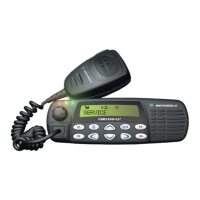_)
Theory
of
Operation 2-17
2.3.6.3 Voice Storage Option
The Voice Storage (VS) can be used to store audio signals coming from the receiver or from the
microphone. Any stored audio
signal can be played back over the radio's speaker or sent out via the
radio's transmitter.
The PTCB hosts
the
Voice Storage circuitry. Voice Storage
IC
U611 provides all the required
functionality and is powered from the
regulated 3.3 volts from U610. The
1-LP
controls U611 via SPI
bus lines CLK (U611-8),
DATA
(U611-10) and MISO (U611-11).
To
transfer data, the
1-LP
first selects
the U611 via line VS CS and U611 pin
9.
Then the
1-LP
sends data through line
DATA
and receives
data through
line MISO. Pin 2 (RAC)
of
U611 indicates the end
of
a message row
by
a low state for
12.5 ms and connects
to
1-LP
pin 65. A low at pin 5
(I
NT), which is connected
to
1-LP
pin 55, indicates
that the Voice Storage
IC requires service from the
1-LP.
Audio, either from the radio's receiver or from one
of
the microphone inputs, emerges from the
ASFIC CMP (U404) at pin 43, through switch U608-1 that is selected by the
1-LP
via ASFIC CMP pin
5 (DACR) and then enters the voice storage
IC
U611 at pin 25. During playback, the stored audio
emerges from U611 at pin
20.
To
transmit the audio signal, it
is
fed through resistive divider R657 I
R658, through switch U608-3 and through line EXT MIC. When this path
is
selected, the audio
signal enters the ASFIC CMP at pin 48 and
is
processed like normal transmit audio.
To
play the
stored audio over the radio's speaker, the audio from U611 pin
20 is buffered by op-amp U605-1,
through switch U608-2 and fed via
line FLAT RX SND to ASFIC CMP pin 10 (UIO).
In
this case, this
ASFIC CMP pin is programmed as input and feeds the audio signal through the normal receiver
audio path to the speaker or handset. Switches U608-2 and U608-3 are
controlled by the
1-LP
via
ASFIC CMP pin 6 (DACG) and feed the stored audio only to the ASFIC CMP port UIO when it is
programmed as input.

